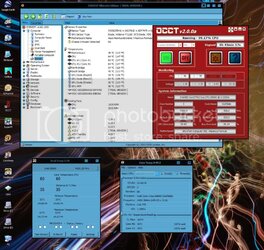Hi, im a bit of a noobie overclocker that would welcome some help.
Basically i've so far overclocked my E8600 to 4.2ghz stable but am unsure about going further because i am getting different temp readings with different programs and im not sure which are correct.
When OCCT has been running for a while @ 4.3ghz i get the following temps from each of these programs:
Realtemp: 60c
Everest: 64c
Coretemp: 70c
OCCT: 70c

if OCCT and coretemp are correct then i dont really want to take this further, but im not sure they are. Someone told me that realtemp is more accurate in which case I can keep going with the o/c but i wanna be sure which is the correct reading before i carry on.
I think its something to do with the TJmax that is causing these inconsistencies but as i said im a noob so not sure what that is.
other info:
VID = 1.25
vcore = 1.38 (for 4.3ghz), loadline calibration enabled, all other voltage settings on auto
im using a thermalright ultra 120 extreme with a sharkoon 2000rpm fan, asus maximus formula (bios rev. 1207).
would be very grateful if anyone can point out which is correct/incorrect and what I am doing wrong, thanks
Basically i've so far overclocked my E8600 to 4.2ghz stable but am unsure about going further because i am getting different temp readings with different programs and im not sure which are correct.
When OCCT has been running for a while @ 4.3ghz i get the following temps from each of these programs:
Realtemp: 60c
Everest: 64c
Coretemp: 70c
OCCT: 70c

if OCCT and coretemp are correct then i dont really want to take this further, but im not sure they are. Someone told me that realtemp is more accurate in which case I can keep going with the o/c but i wanna be sure which is the correct reading before i carry on.
I think its something to do with the TJmax that is causing these inconsistencies but as i said im a noob so not sure what that is.
other info:
VID = 1.25
vcore = 1.38 (for 4.3ghz), loadline calibration enabled, all other voltage settings on auto
im using a thermalright ultra 120 extreme with a sharkoon 2000rpm fan, asus maximus formula (bios rev. 1207).
would be very grateful if anyone can point out which is correct/incorrect and what I am doing wrong, thanks
Last edited: